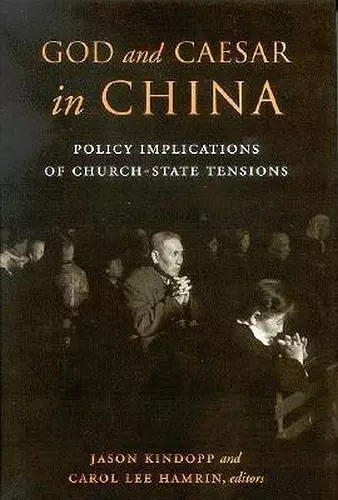God and Caesar in China
Policy Implications of Church-State Tensions
Carol Lee Hamrin author Jason Kindopp author Carol Lee Hamrin editor Jason Kindopp editor
Format:Paperback
Publisher:Bloomsbury Publishing PLC
Published:21st Apr '04
Currently unavailable, and unfortunately no date known when it will be back

In the late 1970s when Mao's Cultural Revolution ushered in China's reform era, religion played a small role in the changes the country was undergoing. There were few symbols of religious observance, and the practice of religion seemed a forgotten art. Yet by the new millennium, China's government reported that more than 200 million religious believers worshiped in 85,000 authorized venues, and estimates by outside observers continue to rise. The numbers tell the story: Buddhists, as in the past, are most numerous, with more than 100 million adherents. Muslims number 18 million with the majority concentrated in the northwest region of Xinjiang. By 2000 China's Catholic population had swelled from 3 million in 1949 to more than 12 million, surpassing the number of Catholics in Ireland. Protestantism in China has grown at an even faster pace during the same period, multiplying from 1 million to at least 30 million followers. China now has the world's second-largest evangelical Christian populationbehind only the United States. In addition, a host of religious and quasi-spiritual groups and sects has also sprouted up in virtually every corner of Chinese society. Religion's dramatic revival in post-Mao China has generated tensions between the ruling Communist Party state and China's increasingly diverse population of religious adherents. Such tensions are rooted in centuries-old governing practices and reflect the pressures of rapid modernization. The state's response has been a mixture of accommodation and repression, with the aim of preserving monopoly control over religious organization. Its inability to do so effectively has led to cycles of persecution of religious groups that resist the party's efforts. American concern over official acts of religious persecution has become a leading issue in U.S. policy toward China. The passage of the 1998 International Religious Freedom Act, which institutionalized concern over religious freedom abroad in U.S. foreig
This illuminating book is essential reading for anyone interested in gaining a better understanding of the hopes and challenges faced by Christians in China. The contributors provide vital historical context in detailing the complex struggle between church and state that is unfolding in the world's most populous country. The tale is both inspirational and sobering. It is presented with commendable objectivity. The result is a slim volume filled with useful insights for policymakers and concerned citizens alike."- J. Stapleton Roy, former U.S. ambassador to China;
"To my knowledge there is no other publication that gives such an excellent overview of the Christian experience in China and presents such original discussion of the policy implications of U.S. and Chinese religious policies. The collection of chapters is exceptionally well organized and sequenced. I found myself reading the book eagerly."- Deborah Davis, professor of sociology, Yale University;
"Jason Kindopp and Carol Hamrin have produced a compelling account of China's complicated struggle with religion. The historic roots of this struggle go back thousands of years as the state has tried to control religious movements, and these movements have tried to influence and change China outside of state control. Kindopp and Hamrin emphasize the surge of religion as an indigenous force, and the Chinese government, which first tried to eliminate it, has now sought compromise and a modus vivendi. How this plays out will profoundly affect us all."- James R. Lilley, former U.S. ambassador to China
ISBN: 9780815749370
Dimensions: unknown
Weight: unknown
200 pages